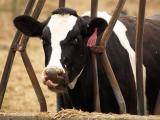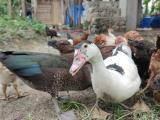May 29, 2007 (CIDRAP News) - Four people in Wales and northwest England have tested positive for the low-pathogenic H7N2 avian influenza subtype found last week in chickens at a small farm in Wales, and local public health authorities suspect some degree of human-to-human transmission of the disease.
England's Health Protection Agency (HPA), in announcing the positive tests 4 days ago, said five other patients whose test results were negative for the virus are undergoing treatment as a precaution because they had similar illnesses. All of the patients who tested positive for the virus had contact with infected birds, the HPA said.
The National Public Health Service (NPHS) for Wales said in a statement today that of 221 people who were identified as contacts so far, 12 are ill with conjunctivitis or a nonserious flulike illness. The NPHS said it could not rule out human-to-human spread of the virus but that it had no laboratory confirmation of such cases.
"Of the people with conjunctivitis or a flulike illness, some did not have close contact with infected poultry," said Marion Lyons, lead consultant in communicable disease control for the NPHS, in the press release.
On May 24 veterinary officials in Wales confirmed a low-pathogenic H7N2 avian influenza outbreak at a farm near the northern town of Denbighshire. For outbreaks of mild strains of avian flu subtypes such as H7N2, public health officials often order culling of birds and monitor human cases because the viruses could mutate into highly pathogenic forms.
Welsh veterinary officials think the infected chickens could have been exposed to the virus on May 7 at the Chelford Market in Cheshire. Tests on birds at another farm in Llyn Peninsula came back negative today, according to a statement from the Welsh government.
Of 221 patients identified as contacts, 171 may have been exposed in a workplace setting, including patients and staff at two hospitals, the NPHS statement said. At one of the hospitals, 79 patients and staff were offered oseltamivir because of contact with a healthcare worker who was treated for the H7 flu virus. Lyons said in the NPHS statement that the sick staff member was working between May 21 and 23, when she may have been infectious.
At the other hospital, 69 patients and staff were notified because a patient who had the H7N2 illness was recently treated at the facility. Lyons said the patient was discharged on May 18, and after an 8-day incubation period, anyone who was ill would have had symptoms by May 26. "So we are contacting all staff and patients to ensure that they remained well and to reassure them," she said in the statement.
Lyons said that people who have had contact with individuals who became ill with the H7N2 virus are being offered prophylactic antiviral medication.
"Investigations also show that, when it spreads from person to person, the illness experienced becomes milder," she said in the press release.
In a related development, children at a primary school in the town where the Welsh farm is located are being given antiviral medication after one of their classmates became ill with suspected H7N2 infection, the London Evening Standard reported today. The ill child visited the affected farm 10 days ago for less than 15 minutes, the Standard report said.
"It is very rare to see this particular flu virus, so we are taking every reasonable precaution to eliminate it from the community, " Brendan Mason, a consultant epidemiologist, told the Standard.
Some infectious disease experts say human illnesses associated with the H7N2 outbreak in Wales are a reminder that other virus subtypes—not just the well-known H5N1 strain—could spark a pandemic.
"There may be a bit of complacency when it comes to recognizing the pandemic potential of H7 viruses," Michael Perdue from the World Health Organization (WHO) told the Associated Press (AP) today.
The number of [H7] human cases seems large for the small number of bird deaths, he told the AP. "Unless there's something unusual about the contact with birds, that suggests the virus is finding new ways of getting to humans," he said in the AP report.
Other experts say the focus on the H5N1 subtype's pandemic potential is justified. "We know that H7 can cause outbreaks in chickens and that it can occasionally jump the species barrier, but it has not done it nearly to the extent of the H5N1 virus," said Anthony Fauci, director of the National Institute of Allergy and Infectious Diseases.
David Halvorson, DVM, a veterinarian in avian health at the University of Minnesota in St Paul, told CIDRAP News that H5 and H7 subtypes both have the ability to generate a highly pathogenic virus of the same subtype, but there's no way to project when and if such evolution will occur. "Whether that will happen quickly, as it did in Chile or British Columbia, or not happen for over 10 years, as it has not done in New York live bird markets, is not predictable," he said.
The WHO's Regional Office for Europe said human illness from other H7 subtypes has occurred in two other instances in the past few years. In 2006 a poultry worker in the United Kingdom was diagnosed with conjunctivitis linked to an H7N3 poultry outbreak, and in 2003 an outbreak of highly pathogenic H7N7 in the Netherlands resulted in 86 confirmed cases of mild illness, with one death—a veterinarian who died from acute respiratory distress syndrome.
See also:
May 29 National Public Health Service for Wales press release



















